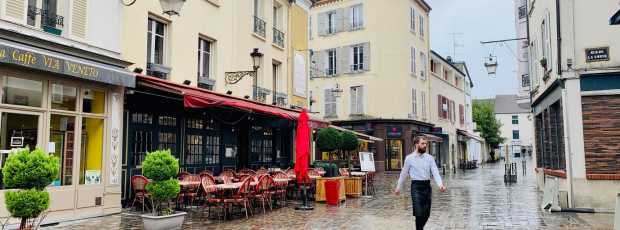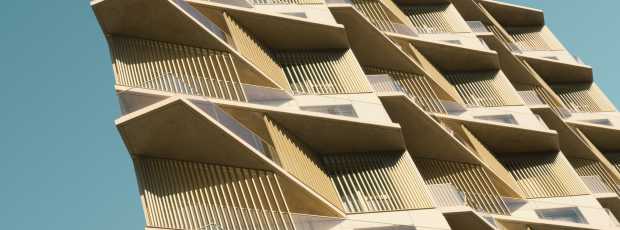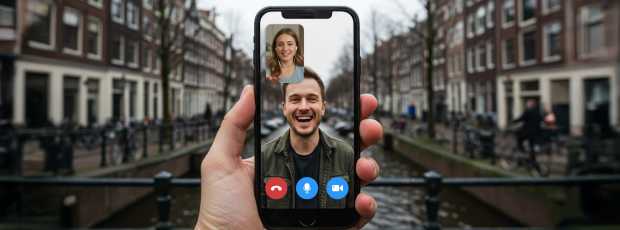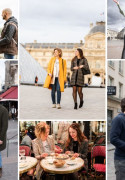Table Of Contents
- Must-Sees: Iconic Paris Attractions Worth Your Time
- Overrated Paris: What You Can Skip
- Authentic Paris Eats: Where Locals Actually Dine
- Signature Local Leisure Culture
- Interest-Based Things to Do in Paris
- Neighborhood Explorations
- Practical Tips for Visiting Paris
- Frequently Asked Questions
- Final Thoughts
Paris is a fantastic place with a unique pace, somewhere between hurried and measured. I've lived here twelve years now, long enough to watch tourist patterns shift and genuine places endure.
This guide balances both approaches to things to do in Paris. I'll show you which famous attractions deserve your time and which ones don't. More importantly, I'll help you plan your Paris experience just like locals actually choose when we want to rediscover our own city.
From essential highlights like visiting the Eiffel Tower strategically, to discovering neighborhood spots that most guides overlook, this collection reflects genuine local knowledge.
For an unforgettable experience, you'll want to explore the hidden gems in Paris that most guidebooks miss entirely.
Must-Sees: Iconic Paris Attractions Worth Your Time
These are the landmarks that shape first impressions of Paris, but they’re only worth it if you approach them with timing and context. Here’s how locals actually do the classics, not to rush them, but to let them land properly.
The Eiffel Tower at Strategic Moments
I've watched countless visitors plant themselves beneath the tower for hours, waiting for that hourly sparkle like it's some kind of urban campfire.
They miss the point entirely. The real moment happens at dusk. That first sparkle against the dying light, when the tower shifts from architectural statement to something softer, more mysterious.
I time my visits for this transition, then walk away. No lingering, no camping with the crowds. Just that single moment when Paris exhales and the iron transforms.
For viewing, locals know two spots worth the walk: Pont Alexandre III gives you the full tower framed by ornate stonework. Place du Trocadéro works for the classic angle, though I prefer it empty, which means dawn or late evening when the tour groups have surrendered.
Morning light reveals the tower's true bones. The clean lines, sharp shadows, and no romantic haze. Evening captures the metamorphosis I mentioned, iron becoming light. Both have their place, but timing makes all the difference. The tower doesn't change; your relationship with it does.
Want to Experience Paris Firsthand?
Step into the neighborhood, scene, or story with someone who knows it inside out.
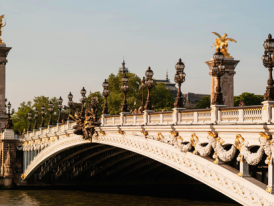
Alexandre III Bridge
Arc de Triomphe: Worth the Climb
I climb the Arc maybe twice a year (if I get time), always for the same reason: to remember how Paris actually works. From street level, the city feels like a maze of narrow passages and sudden squares.
From up there, you see Haussmann's logic; those twelve avenues radiating outward like the spokes of some enormous wheel.
The climb itself is manageable, and the crowds thin out faster here than at most observation points. I go early morning when the light is clean, or late afternoon when shadows start defining the rooftiles.
What strikes me every time is how the view contextualizes everything you'll walk through later. That distant dome? Invalides. Those gardens stretching toward the river? Tuileries. The white steps rising in the distance? Sacré-Cœur.
From here, Paris stops being a collection of destinations and becomes a single, coherent thing.
The Arc sits at the center of it all, Not just geographically, but conceptually. Stand there long enough and you start to feel the city's heartbeat, the way traffic flows and pedestrians navigate between these grand gestures of stone and boulevard.

Arc de Triomphe with sunset traffic
Louvre Museum: Strategic Navigation
The Louvre Museum houses world-class museum collections, but even locals approach it strategically. Book timed entry tickets. Enter through the less crowded Carrousel du Louvre entrance.
Focus on one wing per visit. The Mona Lisa and Venus de Milo are worth seeing once, but don't let long lines dominate your day.
When to Visit Notre Dame Cathedral: Current Reality
Following the devastating fire, Notre Dame Cathedral reopened to the public on December 8, 2024. You can still appreciate Notre Dame's exterior architecture from Île de la Cité and the surrounding area as visits and services are running while restoration continues around the site. The Notre Dame Cathedral reconstruction offers its own historical moment to witness.
I still go early morning when the light hits the remaining stonework cleanly. Sure, it sucks to be up so early, but it's worth the yawns.
The crowds gather later, drawn by the same magnetic pull the cathedral has always possessed, fire or no fire. From the square, you can trace the Gothic lines that survived, understand what made this building worth rebuilding.
The view from Île Saint Louis across the Seine shows the cathedral in its river context. How it anchors this stretch of the city, even wounded. I prefer this angle sometimes; it gives you the building's relationship to the water, to the other islands, to the broader rhythm of Paris.
Luxembourg Gardens: Local Rhythm
Jardin du Luxembourg, the Luxembourg Gardens, moves to a different clock than the rest of tourist Paris. I go there when I need to remember what ordinary Parisian life looks like. Children pushing toy sailboats across the octagonal pond, elderly men absorbed in newspapers on metal chairs, students stretched out on gravel with books.
The formal garden design holds it all together without feeling precious. These aren't museum grounds; they're a neighborhood's backyard that happens to be perfectly proportioned.
Weekday mornings give you the gardens at their most honest. Joggers, dog walkers, people heading to work who've chosen the long route through beauty. Weekend afternoons reveal the social architecture: families claiming their usual spots, friends meeting at predetermined benches, lovers finding their corner of shade.
My personal recommendation: Bring a book and claim one of those green chairs near the Medici Fountain. Stay long enough to watch the light change through the trees.
Place de la Concorde: Brief But Significant
Place de la Concorde anchors the city's grand axis from the Louvre to the Champs-Élysées. Five minutes here provides historical context and urban planning appreciation. Don't linger unless you enjoy traffic noise.
Seine River Cruise: Choose Wisely
Seine river cruises vary dramatically in quality. Skip dinner cruises and tourist-heavy boat tours. Instead, take the RATP bus 72 along the river that locals use for transport. It stops at key points and functions as sightseeing without the performance.
A simple boat ride offers the same views without forced commentary.
Île de la Cité: Beyond the Cathedral
Île de la Cité contains more than Notre Dame. Sainte-Chapelle's stained glass rivals any church in Europe. The Conciergerie provides a French history context that most visitors miss. Both avoid the cathedral crowds while offering substantial cultural value.
The island also houses the Hôtel de Ville area connections via bridges, linking the central Paris administration with historical religious sites. This geographical relationship illustrates how Notre Dame de Paris sits at the literal and figurative heart of the city's development.
These highlights reward both first-time trip visitors and repeat travelers. For evening versions of these experiences, explore Paris at Night. It feels like a different place!
Curious What Paris Secrets You Won’t Find Online?
Discover the side only locals talk about.
Overrated Paris: What You Can Skip
Not everything famous in Paris is famous for the right reasons. These next stops are the ones that look good on postcards but rarely feel good in real life, and I’ll tell you what to do instead.
The Mona Lisa Mob Scene
I've watched the Mona Lisa crowd from the edges. That dense mass of phones held high, people taking pictures of other people taking pictures. It's become performance art of a different kind, though probably not what Da Vinci intended.
See it once if you need to check that box, but don't build your Louvre visit around thirty seconds of glimpsing a small painting through a forest of devices. The museum holds thousands of works where you can actually stand close enough to see brushstrokes, to breathe in the same space as the art.
The Islamic Art wing runs nearly empty most days, intricate geometric patterns and calligraphy that reward close looking. The medieval sculpture halls echo with footsteps instead of camera clicks. These spaces remember what museums are supposed to feel like: contemplative, not competitive.
The Mona Lisa isn't going anywhere, but your attention is finite. Spend it where you can actually see what you came for.

The Louvre
Champs-Élysées Shopping Circus
The Champs-Élysées has become a tourist shopping mall with global chain stores. Locals avoid it except for movie premieres or New Year's Eve.
Better alternative: Window shopping in Le Marais or Saint-Germain-des-Prés provides actual French boutiques and an authentic neighborhood atmosphere.
Place du Tertre Artist Performances
I walk through Place du Tertre maybe once a year, usually by accident while cutting through Montmartre. The street performers work their routines, portrait artists call out to passing tourists, and everyone plays their assigned role in this open-air theater of "authentic" Parisian artist culture.
It's performance, not creation. The real working artists left Montmartre decades ago when the rents followed the tour buses uphill. What remains is a carefully choreographed atmosphere, convincing enough for the 'must-see' checklist, but hollow if you're looking for genuine creative community.
The actual artists moved to Belleville, to the studios around Canal Saint-Martin, to neighborhoods where rent doesn't require caricature drawings to survive.
Tourist-Trap Bistros Near Major Sites
I've learned to map Paris by its restaurant quality: the closer to famous sights, the worse the food becomes. Two blocks from any major Paris attraction, bistros serve reheated mediocrity at prices that would embarrass the tourists if they knew what real Paris bistros charge.
These places don't need to be good; they need to be convenient, to look the part with their checkered tablecloths and faded awnings. They survive on location, not loyalty.
Walk five blocks in any direction from the tourist circuit. Real bistros operate for the neighborhood, for regulars who'd notice if the sauce changed or the wine list got lazy.
These hidden gem alternatives don't advertise themselves; they don't need to. They're part of the Paris that locals experience daily, where lunch isn't performance art.
Locals know that a proper croissant should shatter when bitten, with visible butter layers. Delicious!
Authentic Paris Eats: Where Locals Actually Dine
Food in Paris isn’t just about taste. It’s about habits, neighborhoods, and knowing what’s worth your appetite. Let’s start with what you should eat, then move into where locals go to eat it.
What Foods You Must Try in Paris
Paris' food and drink experiences and culture center on quality ingredients prepared simply. Forget Instagram-worthy presentations. Focus on technique, sourcing, and timing.
Croissants: The Real Ones
Maison Doucet - Boulangerie-Pâtisserie remains a hidden gem despite being near several metro stations. This family bakery produces croissants with proper lamination and butter content. No tourists queue here at 7 am when fresh batches emerge.
Locals know: a proper croissant should shatter when bitten, with visible butter layers. Avoid any bakery that pre-makes croissants or keeps them under heat lamps.

Fresh Croissants
Award-Winning Bread: Tout Autour du Pain
This upper Marais bakery has been placed three times among the top ten winners of the Best Baguette in Paris competition. Baker Benjamin Turquier also won first prize in the city's Best Croissant in Paris competition.
The French version of excellence: consistent technique over marketing. Visit before 11 AM when bread selection peaks.
Traditional Bistros: Beyond the Tourist Zone
I judge bistros by their barstools and their silences. Real ones have zinc counters worn smooth by decades of elbows, servers who move with the efficiency of people who've found their rhythm, handwritten menus that change with what's good at market that morning.
You can spot them by what they don't do: no English menus taped to windows, no desperate attempts to lure passersby. Instead, look for the regular at the bar with his morning coffee and Le Figaro, the kids' menu that's actually designed for French children, with proper small portions of steak haché and simple pasta, not chicken nuggets masquerading as local cuisine.
These places serve their neighborhood first. The food reflects that loyalty: classic preparations done properly because the customer three stools down has been ordering the same thing for fifteen years and would notice if standards slipped.
Too Many Lists, Not Enough Clarity?
We make exploring simple by connecting you with someone who knows the city and helps you spend your time on what matters to you.
See how it worksMulticultural Eats: Paris Reality
Paris eats more couscous than cassoulet these days, but tourists still hunt for the mythical "authentic French" experience while locals line up for Vietnamese pho and Lebanese shawarma. This isn't cultural confusion; it's Paris as it actually exists.
The 10th and 11th arrondissements tell the real story: North African families running couscous counters, Vietnamese grandmothers ladling pho that would satisfy any Saigon regular, Lebanese bakeries where the bread comes out warm and the conversation flows in three languages.
This is established community food, not fusion experiments for food magazines. These kitchens cook the way their grandmothers did, just relocated to Parisian storefronts where the ingredients are available and the customers understand what real flavor means.
Hungry to Try Paris Delicacies Yourself?
Taste and explore the flavors locals actually love.
Market Culture: Beyond the Postcard
I shop at Marché Saint-Germain when I need vegetables, not photo opportunities. The morning markets run on local schedules: vendors who know their regulars' preferences, shoppers who squeeze tomatoes with practiced fingers, transactions conducted in rapid French over daily necessities.
These aren't cultural performances. They're a functional food culture, the infrastructure that feeds neighborhoods. Marché des Enfants Rouges operates the same way despite its tourist reputation: vendors selling to locals who cook dinner tonight, not visitors collecting Instagram content.
Surprising Personal Recommendation: Shepherd's Pie
Le Roi du Pot au Feu serves shepherd's pie, which sounds impossible until you remember Antoine-Augustin Parmentier. The 18th-century pharmacist who convinced France to eat potatoes left his mark everywhere, including this bistro's interpretation of layered potato comfort.
It's authentically Parisian in the way only Paris manages: taking something foreign and making it local through historical accident and stubborn commitment to doing it properly. French food culture absorbs influences like this constantly, turning immigrant ingredients into neighborhood classics over generations of patient repetition.
For comprehensive food exploration, consider Paris food and drink experiences or read our detailed guide to the best food in Paris.
Signature Local Leisure Culture
Once you’ve seen the monuments and eaten something excellent, the next step is learning how Parisians spend time when they’re not “doing” anything. These small rituals are easy to miss, but they’re what make Paris feel lived in rather than visited.
Café Terrace People Watching
Parisian café culture centers on observation, not conversation. Locals position themselves facing the street, order a single coffee, and watch neighborhood life unfold for an hour. This isn't antisocial behavior, it's active engagement with urban rhythm.
Best café terraces for authentic people watching: Saint-Germain-des-Prés on weekday mornings, Canal Saint-Martin on weekend afternoons, Place des Vosges for elegant observation.
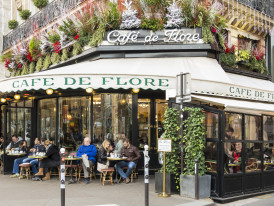
Locals at café terrace, Saint-Germain
Apéro: The Sacred Hour
Apéro culture happens between 6 pm and 8 pm at wine bars and brasseries. Locals order wine or pastis with small plates, transitioning from work to evening. This isn't dinner, it's social recalibration.
Join this ritual at neighborhood wine bars rather than tourist-focused establishments. Order simply and observe social protocols.
Park Afternoons: Unstructured Time
Jardin du Luxembourg and Jardin des Tuileries function as urban living rooms for locals. People bring books, newspapers, or simply sit. This unstructured time reflects Parisian values about leisure and public space.
Participate by claiming a chair, staying at least an hour, and observing without an agenda. This practice connects you to local rhythms more than any organized activity.
Boulangerie Daily Rituals
Locals visit their neighborhood boulangerie daily, often twice: morning for bread, afternoon for pastries. These brief interactions create community connection through shared quality standards and routine.
Choose one bakery during your stay and become a temporary regular. Morning visits establish recognition; afternoon returns deepen local connection.
This authentic leisure culture reflects reasons to visit Paris that extend beyond monument tourism.
Imagine Experiencing This Side of Paris for Real
A local can show you the vibe, flavors, and hidden gems up close.
Interest-Based Things to Do in Paris
Paris changes depending on what you’re into, art, green space, design, shopping, or just wandering into the right street at the right hour. Pick your angle, and the city starts opening different doors.
Arts & Culture: Beyond the Obvious Museums
I won't pretend to be 'artsy' but I have many friends who pride themselves on their love for and understanding of art. I share their knowledge with total confidence.
Centre Pompidou houses modern and contemporary art in a building that locals either love or hate. The museum's art exhibits change regularly, providing current cultural commentary rather than historical preservation.
The building itself represents 1970s architectural boldness. Even if modern art doesn't appeal, the structure offers Paris design history lessons. Things to do in Paris for art lovers extend far beyond the major museums.
Paris museums collectively house some of the world's finest collections, from classical to contemporary. While our museums like the Louvre draw international attention, smaller institutions offer more intimate experiences. These diverse museums cater to every artistic interest and provide alternatives when major institutions feel overwhelming.
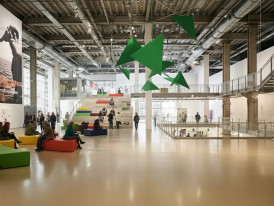
Modern art exhibit at Centre Pompidou
Lesser-known cultural spaces include essential things to do in Paris for culture enthusiasts: Palais de Tokyo for experimental art, Petit Palais for elegant collections without Louvre crowds, and Grand Palais for rotating major exhibitions.
Beautiful Parks: Green Space Strategy
If you want to breathe Parisian air while enjoying privacy, I have some recommendations for you.
Parc des Buttes Chaumont provides hills, lakes, and architectural follies in northeast Paris. This 19th-century design creates romantic atmosphere without central Paris crowds. Among quieter but fun things to do in Paris, this park ranks highly for locals.
Jardin des Plantes combines botanical gardens, natural history museums, and peaceful walks. The adjacent neighborhoods offer authentic Parisian life away from tourist circuits.
Bois de Vincennes serves as eastern Paris's major park, with a medieval castle, lakes, and extensive walking paths. Locals use this for weekend escapes without leaving the city. These represent outdoor things to do in Paris that tourists often miss.
Window Shopping: Authentic Commercial Culture
Le Marais offers independent boutiques, vintage shops, and galleries within medieval streets. Window shopping here reveals Parisian taste rather than international brands. These shopping experiences rank among the favorite things to do in Paris for style-conscious visitors. I'm not an avid shopper myself, but I know Le Marais comes highly recommended by those who are.
Saint-Germain-des-Prés provides upscale window shopping with established fashion houses and antique dealers. The neighborhood maintains commercial elegance alongside residential life.
Avoid major department stores unless seeking specific items. Street-level commerce provides better cultural insight and represents more authentic things to do in Paris.
Go Beyond the Paris Checklist
Discover the city guidebooks don’t cover with a local by your side.
Markets: Weekly Neighborhood Life
I come back to Marché des Enfants Rouges often, a quiet corner of the 3rd where the city keeps its routine. From Tuesday to Sunday, the covered lanes hold produce, bread, and a few stalls that cook while you wait. I stand a moment, watch the steam rise, then choose what looks best. Market visits remain some of the most grounded things to do in Paris, simple and close to daily life.
On Sundays, near the flower stalls on Île de la Cité, I pause where birds and their keepers draw a small crowd. The scene carries an old habit and a link to Parisian pet culture. I take a slow loop, then step back to the river.
Mid-morning works well. Selection peaks, but you can still move. If you want authenticity, this is it.
Design & Fashion: Creative Industries Context
Fashion here is not only luxury windows. In the Marais, there are side streets where independent designers cut patterns above quiet courtyards. Sometimes I cross to Belleville for vintage that feels lived in. In the 12th, I walk the Viaduc des Arts along Avenue Daumesnil, atelier after atelier under the brick arches. Sure, I don't know the latest trends, but it's fun to see others enjoy what they find.
When I can make the time, I spend an hour at the Musée des Arts Décoratifs. Furniture lines, graphic archives, materials that explain how form evolves. Seeing this history sharpens what I notice on the street and adds depth to cultural things to do in Paris.
Neighborhood Explorations
If Paris has a real superpower, it’s that every neighborhood feels like its own small world. Here are the areas that locals return to for atmosphere, not because they’re famous, but because they’re alive.
Le Marais: Medieval Streets, Modern Life
Le Marais balances historical architecture with contemporary Parisian life. Jewish culture, gay community, trendy restaurants, and vintage shopping coexist within medieval street patterns.
Key experiences: afternoon wandering through Place des Vosges, evening drinks at wine bars, weekend browsing of vintage shops and galleries. The neighborhood extends from the Seine north to République, passing near the Hôtel de Ville administrative district that anchors the central Paris government.
Montmartre: Beyond the Tourist Traps
Upper Montmartre around Sacré-Cœur draws tourist crowds, but the neighborhood's lower slopes maintain a village atmosphere. Locals live here year-round, creating an authentic community alongside tourist attractions.
Explore: Rue des Abbesses for local commerce, evening walks through residential streets, and authentic bistros serving neighborhood regulars.
Imagine Experiencing Montmartre for Real
A local can show you the vibe, flavors, and hidden gems up close.
Latin Quarter: Student Energy, Ancient Streets
The Latin Quarter combines university energy with Roman-era street patterns. Bookshops, cafés, and student life create intellectual atmosphere that's survived centuries of urban development.
Best experienced: weekday afternoons when students populate cafés, evening walks through narrow medieval streets, and browsing at Shakespeare and Company bookstore.

Canal Saint-Martin
Canal Saint-Martin: Local Gathering Space
Canal Saint-Martin functions as a linear park where locals picnic, socialize, and relax. The neighborhood around the canal offers independent shops, cafés, and restaurants without tourist crowds.
Visit: weekend afternoons for local social life, evening walks along the water, and exploring side streets for emerging restaurants and bars.
Paris is Not Just a Place on a List
Experience Canal Saint-Martin through hidden corners and stories most visitors miss.
Belleville: Multicultural Paris Reality
Belleville represents contemporary Parisian diversity with North African, Chinese, and emerging artist communities. This neighborhood shows Paris as locals experience it rather than tourist expectations.
Experience: morning markets, authentic ethnic restaurants, and Paris street art throughout residential areas.
Saint-Germain-des-Prés: Literary Legacy, Current Elegance
Saint-Germain-des-Prés maintains intellectual café culture alongside upscale shopping and dining. The neighborhood balances historical literary significance with contemporary Parisian sophistication.
Key activities: morning café visits, afternoon gallery browsing, and evening aperitifs at established wine bars.
Île Saint Louis: Quiet Elegance
Île Saint Louis offers a peaceful residential atmosphere within central Paris. The island's 17th-century architecture and quiet streets provide respite from urban intensity.
Perfect for: afternoon walks, ice cream from Berthillon (famous among locals), and architectural photography.
République to Bastille: Contemporary Paris
The area between République and Bastille showcases contemporary Parisian nightlife, independent restaurants, and local social life. This corridor reflects current Paris culture rather than historical tourism.
For accommodation in these neighborhoods, consult our guide on where to stay in Paris.
Practical Tips for Visiting Paris
A little local strategy goes a long way here, especially with transport, timing, and etiquette. Think of these as the quiet fixes that make everything else in your trip run smoother.
Transportation: Navigate Like a Local
The Paris Metro system connects efficiently to the most popular tourist attractions and neighborhoods. Purchase weekly passes rather than individual tickets if staying more than three days. Gare du Nord and Gare de Lyon serve as major railway stations for arriving from other European cities.
Wear comfortable shoes. Paris remains a walkable city where most interesting discoveries happen on foot between metro stops. The city center allows walking between many Paris attractions.

Paris Metro entrance at Gare du Nord
Language: Effort Matters
Attempt basic French phrases even if you speak limited French. "Bonjour," "merci," and "excusez-moi" demonstrate respect for local culture. Most Parisians appreciate effort over fluency.
Service industry workers often speak English, but beginning interactions in French creates better experiences.
Money and Etiquette: Local Expectations
Most establishments accept credit cards, but small purchases at markets or bakeries may require cash. Tipping isn't mandatory, but rounding up bills shows appreciation.
Restaurant culture expects longer meals than American standards. Don't rush dining experiences or expect immediate attention from servers.
Safety and Common Sense
Paris maintains typical urban safety levels. Tourist-heavy areas attract pickpockets, so secure valuables and maintain awareness. Avoid displaying expensive electronics or jewelry unnecessarily.
Trust instincts about situations and locations. Well-lit, populated areas remain safest for evening activities.
Paris With Kids: Family Trip Considerations
Paris with kids requires planning around meal times and attention spans. Many family-friendly attractions offer reduced admission or special programs. Pack snacks and plan shorter activity segments when exploring Paris with kids.
Public transportation accommodates strollers, and most restaurants provide kids' menu options. Paris with kids works best when balancing educational attractions with playground time and shorter walking distances.
The Eiffel Tower fascinates children, especially the hourly sparkle show. Luxembourg Gardens offers playgrounds, puppet shows, and boat sailing that make Paris with kids more manageable. Many parks include dedicated children's areas.
Museums adapt for Paris with kids' visits: the Louvre offers family tours, the Natural History Museum features dinosaur exhibits, and the Cité des Sciences provides interactive displays. Planning Paris with kids' activities around these specialized programs improves the experience significantly.
For families seeking adventure beyond central Paris, Disneyland Paris provides full-day entertainment approximately 45 minutes from the city center. While Disneyland Paris represents a different experience from authentic Parisian culture, it offers familiar fun for children and complements rather than replaces city exploration.
Consider Paris with kids timing carefully: morning museum visits before afternoon fatigue, lunch breaks at restaurants with kids menu options, and evening activities that don't extend too late. Parks and gardens provide essential rest stops during busy Paris with kids itineraries.
For extended exploration beyond the city, consider day trips from Paris to nearby attractions and regions.
Wish You Could Just Ask a Local?
Book a quick video call and get insider answers to your trip questions.
Frequently Asked Questions
What are the best things to do in Paris for first-time visitors?
First-time visitors should balance iconic attractions with authentic experiences. Visit the Eiffel Tower and Louvre Museum, but also spend time in neighborhoods like Le Marais and Saint-Germain. Take a Seine river cruise, explore Luxembourg Gardens, and experience genuine café culture. Allow time for unstructured wandering between planned activities.
Are 3 days enough for Paris?
Three days provides substantial Paris experience when planned strategically. Focus on 2-3 neighborhoods rather than rushing between distant attractions. Combine major sites (Eiffel Tower, Louvre, Notre Dame area) with local experiences (markets, cafés, parks). This timeline allows meaningful engagement rather than surface-level tourism.
What should I avoid doing in Paris?
Avoid tourist-trap restaurants near major attractions, overpriced Champs-Élysées shopping, and rigid scheduling that prevents spontaneous discoveries. Don't limit yourself to major monuments - Paris rewards neighborhood exploration. Skip fake "authentic" experiences designed for tourists and seek genuine local spots instead.
Is 500 euros enough for 3 days in Paris?
500 euros covers 3 days with moderate dining and activities. Budget approximately 150 euros daily: 50 for meals (mix of cafés and restaurants), 50 for attractions and transport, 50 for shopping and miscellaneous expenses. Free activities like park walks, church visits, and neighborhood exploration extend your budget significantly.
What are the must-see attractions in Paris in 3 days?
Three-day priorities include the Eiffel Tower (especially at night for sparkle), Louvre Museum (with timed entry), Notre Dame area and Île de la Cité, Arc de Triomphe for city views, and Luxembourg Gardens for local atmosphere. Add a Seine boat ride and an evening in Montmartre or Le Marais for a comprehensive experience.
Is the Eiffel Tower worth visiting at night or during the day?
Both times offer different experiences. Daytime visits provide clear photography and surrounding context. Nighttime showcases the hourly Eiffel Tower sparkle and romantic atmosphere. For single visits, the time of arrival for sunset to experience both day and night perspectives during one visit.
What are the top free things to do in Paris?
Free activities include exploring beautiful parks (Luxembourg Gardens, Jardin des Tuileries, Parc des Buttes Chaumont), wandering historic neighborhoods, visiting churches like Sainte-Chapelle's exterior, people watching at café terraces, browsing markets, and enjoying Seine riverbank walks. Many museums offer free admission first Sunday mornings monthly.
Free things to do in Paris also include Eiffel Tower viewing from Champ de Mars or Trocadéro, Notre Dame Cathedral exterior appreciation, Arc de Triomphe exterior views, and extensive neighborhood walking tours you create yourself.
What unique experiences can you only have in Paris?
Paris-specific experiences include watching the Eiffel Tower sparkle, exploring centuries-old covered passages, experiencing genuine café culture, visiting world-class museums housing French collections, walking medieval streets in central city, and participating in daily boulangerie culture. The combination of grand monuments with intimate neighborhood life creates unique things to do in Paris.
Only-in-Paris things to do in Paris include viewing Notre Dame Cathedral's Gothic architecture in urban setting, experiencing the Eiffel Tower's hourly light show, and exploring the juxtaposition of ancient and modern that defines the city center.
What are the best things to do in Montmartre besides visiting Sacré-Cœur?
Montmartre offers wine-making tradition at Clos Montmartre vineyard, artist studios in Place du Tertre (avoiding tourist traps), Moulin Rouge district nightlife, authentic bistros serving locals, vintage shopping on rue des Abbesses, and residential street wandering. The neighborhood balances tourist sites with a genuine village atmosphere.
Alternative Montmartre things to do in Paris include sunset views rivaling the Eiffel Tower, intimate jazz clubs, and authentic French neighborhood life that tourists rarely experience.
Is Le Marais a good neighborhood for shopping and nightlife?
Le Marais excels in both activities. Shopping includes vintage boutiques, independent designers, Jewish quarter specialty shops, and art galleries. Nightlife centers on wine bars, cocktail lounges, and late-night restaurants. The neighborhood's medieval architecture creates a unique atmosphere for both daytime browsing and evening socializing.
What can I do in the Latin Quarter in one afternoon?
One afternoon covers Shakespeare and Company bookstore, Pantheon exterior, student café culture observation, narrow medieval street exploration, browsing bouquinistes (book sellers) along the Seine, visiting Saint-Séverin church, and ending with aperitifs at local wine bars. The area rewards walking and spontaneous discoveries.
Which Paris neighborhoods are best for art lovers?
Art lovers should explore Le Marais for galleries and design shops, Montmartre for artist history and studios, Saint-Germain-des-Prés for established galleries, Belleville for street art and emerging artists, and areas around Centre Pompidou for the contemporary art scene. Each neighborhood offers different aspects of Parisian art culture.
Where can I find the best croissants and pastries in Paris?
Local favorites include Maison Doucet near multiple metro stations, Tout Autour du Pain in upper Marais (award-winning), and neighborhood boulangeries serving residential areas rather than tourist zones. Avoid bakeries near major attractions. Look for places where locals queue in the morning and afternoon for fresh produce.
What are the top Paris food markets locals recommend?
Marché des Enfants Rouges offers covered market atmosphere with food stalls, Marché Saint-Germain serves upscale neighborhood clientele, and rotating weekly markets in residential areas provide authentic local experience. Visit mid-morning when selection peaks.
Where can I try authentic French cuisine without breaking the bank?
Authentic, affordable dining requires avoiding tourist areas. Explore bistros 5+ blocks from major attractions, lunch at wine bars with small plates, visit neighborhood brasseries serving locals, and try ethnic restaurants reflecting Paris's multicultural reality. Prix fixe lunch menus at quality restaurants offer fine dining at reduced prices.
What are the best museums to visit besides the Louvre?
Alternative museums include Musée d'Orsay for Impressionist art in a former railway station, Centre Pompidou for modern and contemporary art, Musée Rodin with sculpture garden, Petit Palais for elegant collections, and Musée des Arts Décoratifs for design history. Each offers substantial collections without Louvre crowds.
These Paris museums provide specialized focus areas that complement the Louvre's comprehensive collections, allowing visitors to explore specific artistic interests in greater depth than possible at larger institutions.
What are the best things to do in Paris in spring (March–May)?
Spring activities include park picnicking when the weather warms, the outdoor café terrace season begins, fewer tourist crowds at attractions, blooming gardens throughout the city, pleasant walking weather for neighborhood exploration, and Easter-season church visits. Markets and outdoor activities become more enjoyable as temperatures rise.
Spring represents ideal timing for outdoor things to do in Paris, when gardens bloom and café terraces reopen for the season.
What festivals or events happen in Paris in summer?
Summer events include Fête de la Musique (June 21) with free concerts citywide, outdoor cinema in parks, Seine riverbank beach setup (Paris Plages), extended daylight for evening activities, outdoor restaurant seating expansion, and various neighborhood festivals. Many cultural venues offer outdoor programming during warm months.

A quiet street in Paris
Final Thoughts
Paris rewards those who move between grand monuments and quiet neighborhoods, between tourist sites and local haunts. The city's layers reveal themselves slowly: Roman foundations beneath medieval streets, 19th-century boulevards connecting ancient quarters, contemporary life flourishing alongside historical preservation.
After twelve years here, I've learned that the best things to do in Paris balance planning with spontaneity. Whether you only have a one day in Paris itinerary or plan to spend 2 days in Paris, try to visit the Eiffel Tower, but also discover small parks. Tour the Louvre, but spend equal time wandering neighborhoods. Eat at famous restaurants, but also claim regular spots at local cafés. Authentic things to do in Paris emerge from this balance between iconic experiences and genuine local life.
The difference between City Unscripted experiences and generic tours mirrors this comprehensive approach to things to do in Paris:
- Local perspective vs tourist checklist completion
- Flexible timing vs rigid scheduling
- Authentic neighborhoods vs monument-hopping
- Current Paris culture vs historical tourism only
- Personal recommendations vs guidebook standards
Paris continues evolving while maintaining its essential character. Understanding both aspects creates richer travel experiences than focusing on either alone. Whether you're planning family-friendly Paris with kids adventures or romantic Eiffel Tower evenings, the city accommodates every travel style while maintaining its distinctive character. (I know taking good photos despite the surrounding beauty can be tough, and there's nothing wrong with reading up on the best Eiffel Tower photo spots!)
The most rewarding things to do in Paris often happen between planned activities: unexpected café conversations, spontaneous market discoveries, quiet moments in neighborhood squares. These experiences complement major attractions like the Eiffel Tower and Notre Dame Cathedral, creating comprehensive Paris memories.
Whether this is your very first trip or return visit, Paris offers discoveries proportional to curiosity invested. You don't even need to speak French to have fun when you visit Paris.
The city rewards attention, patience, and willingness to look beyond obvious attractions. From essential things to do in Paris like Eiffel Tower visits to discovering hidden neighborhood gems, every experience adds layers to your understanding.
More Paris Adventures
Ready to Plan Your Perfect Day in Paris?
Start your experienceTravel Guides Can Only Take You So Far
City Unscripted connects travelers with locals who shape days that actually fit your interests, not someone else’s checklist.
See how it worksWish You Had a Local Friend in Paris
One who knows the city inside out and could plan a private day just for you? Our local hosts do exactly that: no scripts, no tourist traps, just the side of the city most people miss.





